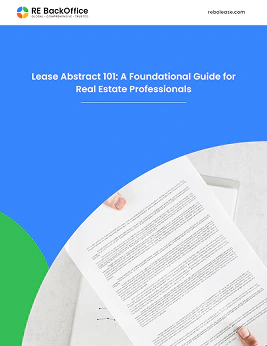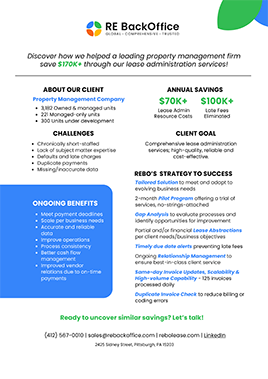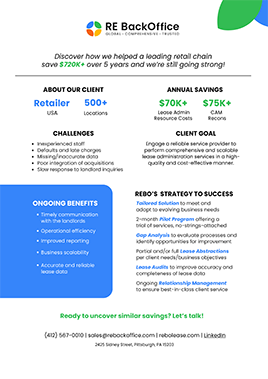
In the commercial real estate world, CAM reconciliation is a vital yet complex aspect of lease management that can significantly impact both landlords and tenants. Common Area Maintenance (CAM) charges encompass the expenses related to the upkeep and maintenance of shared spaces in commercial properties. Tenants contribute to these costs based on their lease agreements, making accurate
CAM reconciliation essential. Outsourcing CAM reconciliation to a trusted lease administration service provider is becoming an increasingly popular solution.
Understanding CAM Reconciliation
CAM reconciliation is the process of reviewing and verifying the shared maintenance costs tenants are responsible for, ensuring these charges are accurate and comply with the lease terms. This annual procedure involves comparing estimated CAM expenses charged throughout the year with the actual expenses incurred. Any discrepancies are then adjusted, leading to either additional charges or refunds for tenants.
The Challenges of CAM Reconciliation
CAM reconciliation is inherently complex, involving numerous variables that can make the process both time-consuming and difficult to manage. These complexities arise from the diverse nature of cost components, the variability of lease terms among tenants, and the critical need for accuracy and transparency in the reconciliation process. Understanding these challenges in detail highlights the importance of outsourcing CAM reconciliation to a trusted lease administration service provider.
Varied Cost Components
One of the primary challenges in CAM reconciliation is the wide range of cost components that are included in CAM charges. These costs cover all the shared expenses necessary to maintain and operate common areas in commercial properties. Some common examples include:
- Landscaping and Grounds Maintenance: This includes the cost of maintaining lawns, gardens, trees, and other outdoor spaces. Regular upkeep, seasonal planting, and pest control are part of these expenses.
- Security Services: This encompasses expenses related to on-site security personnel, security systems, surveillance cameras, and monitoring services to ensure the safety of the property.
- Repairs and Maintenance: Routine maintenance and unexpected repairs for shared facilities such as elevators, HVAC systems, plumbing, and electrical systems fall under this category.
- Utilities: Shared utility costs, including water, electricity, and gas for common areas, are a significant part of CAM charges.
- Cleaning Services: The cost of janitorial services for lobbies, restrooms, hallways, and other communal areas are included.
- Snow Removal: In colder climates, the expense of snow removal from parking lots, sidewalks, and other communal areas is necessary.
- Insurance: Property insurance premiums that cover shared areas are also a part of CAM expenses.
- Property Management Fees: Fees paid to property management companies for their services in maintaining and overseeing the property.
The diversity of these cost components can vary significantly from one property to another, making it difficult to standardize and accurately allocate them among tenants. Each expense must be meticulously documented, justified, and apportioned according to the specific terms outlined in the tenants' lease agreements.
Different Lease Terms
Another layer of complexity in CAM reconciliation arises from the variability in lease terms among tenants. Each tenant's lease agreement can have distinct provisions regarding their share of CAM expenses. These differences can include:
- Pro Rata Share: Tenants may pay a percentage of the total CAM costs based on the square footage they occupy relative to the total leasable area of the property. Calculating this share accurately is crucial.
- Expense Caps: Some leases include caps on the amount of CAM expenses that can be passed on to tenants. These caps might be fixed or subject to annual increases.
- Base Year Calculations: Certain leases use a base year method, where tenants pay for increases in CAM costs over a base year. Identifying and calculating these increases requires detailed historical data and precise adjustments.
- Exclusions and Inclusions: Lease agreements often specify which CAM expenses are recoverable and which are not. For example, capital improvements might be excluded, while routine maintenance is included.
- Gross-Up Clauses: In buildings with varying occupancy levels, gross-up clauses might be used to adjust CAM charges to reflect full occupancy, ensuring fair cost distribution.
Given these varying lease terms, it is essential to apply the correct calculations and methodologies to ensure each tenant is charged accurately and fairly. Misinterpretation of lease terms or errors in calculations can lead to disputes, overcharges, or undercharges, all of which can strain tenant-landlord relationships.
Accuracy and Transparency
Ensuring accuracy and transparency in CAM reconciliation is perhaps the most challenging aspect. Tenants expect and deserve to understand precisely what they are being charged for and to see that these charges are justified and correctly calculated. Achieving this level of accuracy and transparency involves several critical steps:
- Detailed Record Keeping: Accurate and comprehensive records of all CAM expenses must be maintained throughout the year. This includes invoices, receipts, and any documentation supporting the expenses incurred.
- Regular Audits: Periodic audits of CAM expenses help identify discrepancies and ensure that all charges are legitimate and accurately recorded. These audits can be internal or conducted by third-party professionals.
- Clear Communication: Transparent communication with tenants about how CAM charges are calculated and allocated is essential. Providing detailed breakdowns and explanations helps build trust and prevent misunderstandings.
- Compliance with Lease Terms: Strict adherence to the terms specified in each tenant's lease is crucial. Any deviation can lead to disputes and potential legal challenges.
- Utilizing Technology: Advanced software solutions can assist in tracking expenses, generating reports, and automating calculations, reducing the risk of human error and enhancing transparency.
Moreover, landlords and property managers must be prepared to answer any questions tenants might have regarding their CAM charges. This level of transparency not only fosters trust but also helps in maintaining positive tenant-landlord relationships.
The intricate nature of CAM reconciliation, with its varied cost components, different lease terms, and the need for accuracy and transparency, underscores why many tenants are turning to outsourcing CAM reconciliation to a trusted lease administration service provider. These providers bring the necessary expertise, technology, and resources to manage the complexities of CAM reconciliation effectively, ensuring that tenants are charged accurately and fairly while freeing up valuable time and resources for their core business.
The Advantages of Outsourcing CAM Reconciliation
Outsourcing CAM reconciliation to a trusted lease administration service provider offers tenants several significant benefits:
Expertise and Accuracy
Service providers specializing in CAM reconciliation possess in-depth knowledge and expertise. They are well-versed in lease terms, cost components, and industry standards. This expertise ensures that the CAM reconciliation process is accurate and compliant, minimizing errors and discrepancies. Tenants can trust that their CAM charges are being handled by professionals who understand the nuances of the process.
Cost Savings
Outsourcing CAM reconciliation can lead to substantial cost savings for tenants. In-house management of CAM charges requires significant time and resources, diverting attention from core business activities. By outsourcing, tenants can reduce administrative overheads and focus on their primary business operations. Additionally, accurate reconciliation can prevent overpayments and identify potential cost-saving opportunities.
Time Efficiency
The time-consuming nature of CAM reconciliation can burden tenants, especially those with multiple leases. Outsourcing this task frees up valuable time for tenants, allowing them to concentrate on strategic business initiatives. Lease administration service providers streamline the reconciliation process, ensuring timely and efficient completion.
Access to Advanced Technology
Leading lease administration service providers use advanced software and technology to manage CAM reconciliation. These tools enhance accuracy, provide detailed reports, and offer real-time insights into CAM charges. Tenants benefit from sophisticated technology that simplifies the reconciliation process and ensures transparency.
Risk Mitigation
Outsourcing CAM reconciliation to a trusted lease administration service provider reduces the risk of errors, non-compliance, and disputes. Service providers adhere to best practices and regulatory requirements, ensuring that CAM charges are accurate and justified. This proactive approach mitigates potential legal and financial risks for tenants.
Enhanced Transparency and Reporting
Outsourcing CAM reconciliation offers tenants enhanced transparency and detailed reporting. Service providers generate comprehensive reports that break down CAM charges, making it easier for tenants to understand and verify expenses. This transparency fosters trust and accountability between tenants and landlords.
Scalability and Flexibility
Outsourcing CAM reconciliation provides scalability and flexibility, catering to tenants with varying needs. Whether a tenant has a single lease or multiple properties, service providers can adjust their services accordingly. This flexibility ensures that tenants receive tailored solutions that align with their specific requirements.
Improved Tenant-Landlord Relationship
Accurate and transparent CAM reconciliation contributes to improved tenant-landlord relationships. When tenants have confidence in the reconciliation process, it reduces disputes and fosters a positive working relationship with landlords. Outsourcing CAM reconciliation to a trusted lease administration service provider ensures that both parties are on the same page regarding shared maintenance costs.
Choosing the Right Lease Administration Service Provider
To maximize the benefits of outsourcing CAM reconciliation, tenants must choose the right lease administration service provider. Key considerations include:
- Experience and Expertise: Look for providers with a proven track record in CAM reconciliation and lease administration.
- Technology and Tools: Ensure the provider uses advanced software and technology to enhance accuracy and transparency.
- Customization and Flexibility: Select a provider that offers scalable and customizable solutions to meet your specific needs.
- Reputation and References: Check references and reviews to gauge the provider's reputation and reliability.
- Compliance and Best Practices: Ensure the provider adheres to industry standards and regulatory requirements.
Outsourcing CAM reconciliation to a trusted lease administration service provider offers numerous benefits for tenants, including expertise, cost savings, time efficiency, and risk mitigation. By leveraging advanced technology and specialized knowledge, service providers streamline the reconciliation process, ensuring accuracy and transparency. This practice not only enhances tenant-landlord relationships but also allows tenants to focus on their core business activities. As the complexities of CAM charges continue to grow, outsourcing CAM reconciliation emerges as a strategic solution that empowers tenants to navigate the challenges of lease management with confidence.
Incorporating outsourcing CAM reconciliation into your lease management strategy can transform a daunting task into a streamlined, efficient process. As tenants seek to optimize their operational efficiencies and reduce administrative burdens, the expertise and technology offered by trusted lease administration service providers become invaluable. By choosing the right partner, tenants can ensure that their CAM reconciliation is handled with precision and transparency, ultimately leading to more accurate financial outcomes and stronger tenant-landlord relationships.
In summary, the benefits of outsourcing CAM reconciliation to a trusted lease administration service provider are clear. Tenants gain access to specialized expertise, reduce costs, save time, and mitigate risks. The use of advanced technology enhances transparency and reporting, while scalability and flexibility ensure tailored solutions for various needs. Improved tenant-landlord relationships further underscore the value of outsourcing this critical process. As commercial real estate continues to evolve, outsourcing CAM reconciliation stands out as a strategic move that empowers tenants to navigate the complexities of lease management with ease and efficiency.


